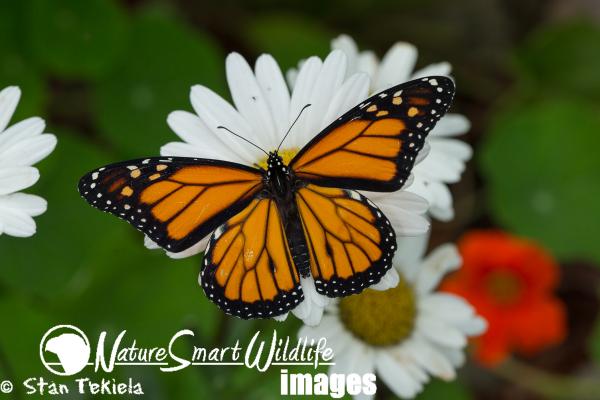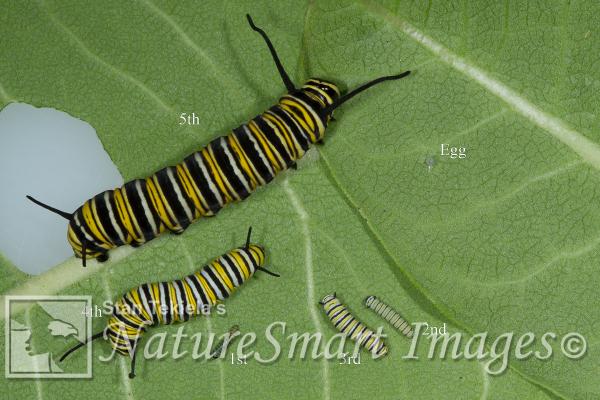View all of the titles in the
NatureSmart Bookstore


by Stan Tekiela
© NatureSmart
October 7, 2019
When you think about all of the amazing animals in this world your mind tends to think about the large furry critters such as bears or moose. Yes, there are many crazy cool critters in this world. In fact, there are about 5,000 mammals in the world.
But at this time of year, when I think about amazing critters, my mind turns to the tiny and delicate Monarch Butterfly. Ya, that’s right, a butterfly! Sure, you might be thinking, butterflies are interesting but are they really all that cool? I would respond with, oh yes they are!
In late summer the Monarch Butterfly preforms the first of several mind-bending behaviors. All of the Monarchs you are seeing in late summer are flying south in an unprecedented migration that no other insect performs. All of the Monarch Butterfly’s in the eastern half of the country are heading for the mountains of central Mexico where they will spend the winter.
How this tiny winged insect manages to navigate thousands of miles to Mexico is still unknown. Millions of Monarchs spend the winter clinging to trees and taking short flights on warm winter days. Next spring, they leave Mexico and start to fly north, but they only make it to the southern border states such as Texas. The Monarchs then mate and lay eggs, then they die, never returning to their birthplace.
Adult Monarch Butterfly’s only lay their eggs on milkweed plants. After mating the female flits around and lands on a variety of plants. She drums the surface of the leaf with her front feet and can identify the kind of plant from the scent that arises from the drumming. If she is on a milkweed plant, she bends her abdomen around the edge of the leaf and deposits a tiny whitish egg on the underside of the leaf. In a short time, the egg hatches and a very tiny caterpillar emerges.
The caterpillars feed exclusively on milkweed plants. Inside the leaves and stems of the milkweed plants is a white milky sap that contains cardiac glycosides. These cardiac glycosides are a class of compounds that cause increased heart rate, increase respiration and a flushed feeling. In some cases, it causes nausea and vomiting. In short, the milky sap inside milkweed plants is toxic. However, the Monarch caterpillar eats the leaves and the toxic sap with impunity.
As the caterpillar grows and feeds more and more on the milkweed, the caterpillar itself becomes toxic if eaten by a predator such as a bird. Eventually the caterpillar matures and seeks out a sheltered spot to change into a butterfly. This is nothing short of mind blowing. The fully-grown caterpillar spins a silken pad in which it grabs ahold of and hangs down. Its body is slightly curved and looks like the letter J.
The skin on the back of the caterpillar splits open and slides off leaving a bright green sac, at which point it is called a chrysalis. Inside the chrysalis, all the caterpillar’s cells liquify and reorganize and regenerate to form a completely new life form, the butterfly.
In a short time, the Monarch Butterfly emerges from the chrysalis. The adult Monarch Butterfly flies northward following the spring weather. Along the way, the butterfly feeds and then mates. Each female lays upwards of 500 eggs before she will also perish. The next generation goes through all the same steps to become an adult. During summer a third and fourth generation Monarch Butterfly goes through the same process and eventually the Monarch Butterfly makes it way to the northern tier states and into Canada. It is about the fifth generation of butterfly that will turn around and make the journey south back to Mexico where its great, great, great, great grandparents started.
So, at this time of year, if you see a Monarch Butterfly you know this amazing insect is on a mission to make its way back to Mexico. Without this migratory generation we won’t have any Monarchs next year. What an amazing insect! Until next time…
Stan Tekiela is an author / naturalist and wildlife photographer who travels the U.S. to study and capture images and video of wildlife. He can be followed on www.facebook.com and twitter.com. He can be contacted via his web page at www.naturesmart.com.
The nationally syndicated NatureSmart Column appears in over 25 cities spanning 7 states: Minnesota, Wisconsin, Michigan, Illinois, Ohio, New York and Pennsylvania. It is a bi-weekly column circulated to over 750,000 readers.
Wolves
Just the day before, a pack of wolves known as the Wapiti, had found a large bull bison that was weak and injured. Based on its size, this big boy was near the end of its lifespan and the winter weather was taking its toll. For a full day the wolves tried to approach the bison but when the bison...
Moose
It was one of those dark and cloudy winter days in Yellowstone National Park where the clouds are so heavy and low, you feel like you can reach up and touch the cloudy sky. A light wind helped to blow the falling snow with occasional gusts of wind causing swirls of fluffy white snow...
American Badger
It’s funny, I believe the average person knows more about the Honey Badger (Mellivora capensis), a critter of Africa and Southwest Asia than they do about the badger in our own backyard, the American Badger (Taxidea taxus). Social media has a lot to do with the Honey Badger phenomena and...
Backyard Bird Feeding
Winter bird feeding is one of the most common / popular hobbies in America. It is estimated that nearly 60 million Americans feed birds in their yards in winter or summer. That is about 40 percent of all American’s make backyard bird feeding part of their everyday activities. It’s...
View all of the titles in the
NatureSmart Bookstore
Check out Stan's latest photos at
NatureSmart Wildlife Images
Take a tour with Stan.
» More Info
Hear Stan on radio stations all across the Midwest.
» More Info

When he's out in the field, Stan relies on his Vortex Razor binoculars and Vortex Razor spotting scope to help find the subjects for his award winning wildlife photography.

For thirty years, professional wildlife photographer Stan Tekiela has counted on Hunt's Photo and Video to provide him with professional photography equipment.
From tripods to camera bodies and lenses, Hunt's has been Stan's place for everything that he needs. Personal service and prompt shipping means Stan can count on Hunt's to support his professional wildlife photography career.


Professional Wildlife Photographer Stan Tekiela always uses Feeder Fresh in his seed feeders to help keep the feeders and food dry, clean and mold free.
He also uses Feeder Fresh Nectar Defender in all of his hummingbird feeders. It safely keeps nectar fresh longer.